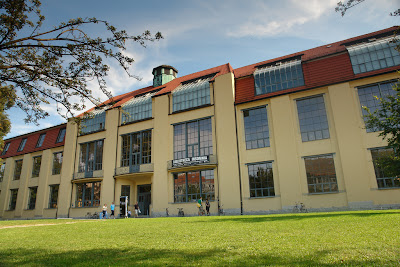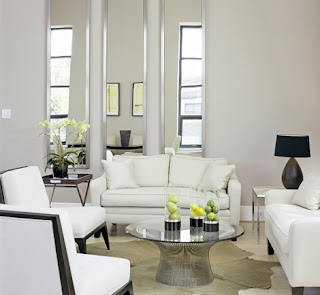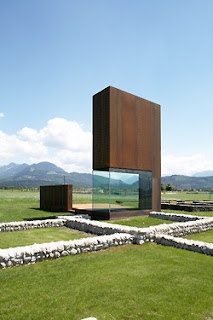We have been given a theme to research over Christmas. I received:
'The Bauhaus'
Bauhuas: "School of Building"
The Bauhaus style became one of the most influential currents in Modernist architecture and modern design.
Bauhuas: "School of Building"
The school was founded by Walter Gropius in Weimar in 1919.
It operated from 1919 to 1933.
Commonly known simply as Bauhaus, was a school in Germany that combined crafts and the fine arts, and was famous for the approach to design that it publicized and taught.
The Bauhaus style became one of the most influential currents in Modernist architecture and modern design.
Walter Gropius, "Bauhuas Manifesto and program" (1919)
I have taken some of the main points from the manifesto that I found interesting:
Architects, painters, and sculptors must recognize anew and
learn to grasp the composite character of a building both as an entity and in its separate parts.
When young people who take a joy in artistic creation once more begin their life's work by learning a
trade, then the unproductive “artist” will no longer be condemned to deficient artistry, for their
skill will now be preserved for the crafts, in which they will be able to achieve excellence.
Proficiency in a craft is essential to every artist. Therein lies the prime source of creative imagination.
Let us then create a new guild of craftsmen without the class distinctions that raise an
arrogant barrier between craftsman and artist! Together let us desire, conceive, and create the
new structure of the future, which will embrace architecture and sculpture and painting in one
unity and which will one day rise toward heaven from the hands of a million workers like the
crystal symbol of a new faith.
Walter Gropius
Principles of the Bauhaus
Art rises above all methods; in itself it cannot be taught, but the crafts certainly can be.
Range of Instruction
Instruction at the Bauhaus includes all practical and scientific areas of creative work.
A. Architecture,
B. Painting,
C. Sculpture
including all branches of the crafts.
Art rises above all methods; in itself it cannot be taught, but the crafts certainly can be.
Range of Instruction
Instruction at the Bauhaus includes all practical and scientific areas of creative work.
A. Architecture,
B. Painting,
C. Sculpture
including all branches of the crafts.
Students are trained in a craft (1) as well as in drawing and painting (2) and science and theory (3).
Craft training forms the basis of all teaching at the Bauhaus. Every student must learn a craft.
The school existed in three German cities (Weimar from 1919 to 1925, Dessau from 1925 to 1932 and Berlin from 1932 to 1933), under three different architect-directors: Walter Gropius from 1919 to 1928, Hannes Meyer from 1928 to 1930 and Ludwig Mies van der Rohe from 1930 until 1933, when the school was closed by its own leadership under pressure from the Nazi regime.
The pottery workshop

The textile workshop
The metal workshop
Marianne Brandt 1924
Lucia Moholy 1924
Wolfgang Rossger and Friedrich Marby 1924
All information above has been sourced from books:
Strecker, J (2000) The Mad Square, Sydney, Art Gallery of New South Wales
Fiedler, J (2006) Bauhaus, England, Konemann
Chakraborty, K.J. (2006) Bauhaus Culture, Minnesota, University of Minnesota Press
Stein, J (1976) Bauhaus, London, Massachusetts Institute of Technology
Droste, M (2006) Bauhaus Archive, Los Angeles, Bauhuas-Archiv Museum fur Gestaltung Klingelhoferstr
Continued Bauhaus Research
Bauhaus Furniture
Bauhaus Furniture Designers
During the mid of the 20Th century, Bauhaus Furniture movement reached unprecedented level of design and creation,it was the breaking point from the dark-heavy traditional classic furniture..modern designs with functionality and simplicity start emerging in Charles Eames furniture,Mies Van Der Rhoe,Arne Jacobsen.Josef Hoffmann.Le Corbusier,Eileen Gray,Florence Knoll and many more..
During the mid of the 20Th Century, Bauhaus furniture movement went hand in hand with the architectural and technological progress,furniture designers combined all the elements of Art graphic,architecture,new technological materials such as the application of Fibreglass in Eames designs or the metal rod bending techniques in Harry Bertoia designs,all together to create a timeless and beautiful furniture designs..Many Bauhaus leading names in Architecture were also household names in designer furniture and designed some of the most iconic pieces in modern classic furniture history.
In keeping with the philosophy of form following and adding to function, the pieces are typically constructed using durable and readily available materials such as steel, leather and fabrics (many of which were produced by the school itself). Production was always a major concern and all furniture was designed to be able to build in a mass production type of mentality. This was necessary in order to make it wide spread and keep production costs low, while maintaining a consistent and available product.
Marcel Breuer, Tubular steel chair design 1928
Marcel Breuer, Tubular steel armchair, design 1926
Walter Gropius, Cabinet for periodicals, design 1923
Le Corbusier and Pierre Jeanneret, Tubular steel bed from the Weissenhof-Siedlung, 1927
Ludwig Mies van der Rohe, Tubular steel chair, design 1927
Arne Jacobsen's Designs : ( 1902-1971 )
The Egg Chair
Mies Van Der Rhoe Ludwig Designs (1886-1969 )
Barcelona Daybed
Barcelona Chair and Sofa
Josef Hoffmamm (1870-1956)
Kubus Armchair collection
Verneer Panton ( 1926 - 1998 )v
Panton Amoebe Lounge Chair
Warren Platner ( 1919-2006 )
PLATNER COFFEE TABLE KNOLL STYLE
Eero Saarinen ( 1910 - 1961 )
SAARINEN TULIP DINING TABLE FIBREGLASS
SAARINEN LARGE DINING TABLE MARBLE CARRERA
Saarinen Womb Chair and Ottoman
Charles Eames:( 1907-1978 )
Sculpture
During the Weimar period, two separate sculpture workshops operated at the Bauhaus: one for stone work, one for wood-carving. To begin with, Johannes Itten directed both, and in 1922 was succeeded by Oskar Schlemmer. The supervising master-craftsman (later famous for his Bauhaus-style chess set) was the sculptor Josef Hartwig. At Dessau a single workshop was set up in 1925 by Joost Schmidt.
At Weimar, in keeping with the focus on architecture, students worked mainly on architectural sculpture. Thus for example in 1921-22, the wood workshop created reliefs and wooden cravings for the Adolf Sommerfeld house designed by Gropius and Meyer, while in 1922-23 the stone workshop produced wall decorations for the Bauhaus' own school buildings.
If the initial emphasis at Weimar was on free artistic work, sculpture classes at Dessau concentrated more on educational aspects. Joost Schmidt's workshop provided an introductory course in sculpture, while students also explored stage design, the creation of maquettes as well as architectural sculpture.
Woman with Infant
Frau mit Säugling, 1919
Tower of Fire
Turm des Feuers, 1920
Owl
Josef Hartwig, Eule, 1922
Light-Space Modulator
László Moholy-Nagy, Licht-Raum-Modulator, 1922-1930, Replik 1970
Architecture
There are a number of characteristics to the Bauhaus/International Style of architecture:
1) It shuns ornamentation and favors functionality
2) Uses asymmetry and regularity versus symmetry
3) It grasps architecture in terms of space versus mass
Bauhaus buildings are usually cubic, favor right angles, (although some feature rounded corners and balconies); they have smooth facades and an open floor plan.
The design style embodied by Walter Gropius became known as the International Style of modern architecture, and later spread to the United States, where it was developed by Mies van der Rohe (1886-1969) and other European emigrants like Richard Neutra (1892-1970).
Bauhaus architecture, whose founding father was Walter Gropius, developed
in Germany in the 1920s and later in the U.S., in the 1930s. The American
form of this architectural style was dubbed the International Style
after Gropius, Mies van der Rohe and other leaders of Bauhaus migrated
to the U.S., with the Nazi’s growing influence. The Bauhaus school
in Dessau was closed on April 11th, 1933, by the police, at the insistence
of the National Socialist government.
Purists assert that Bauhaus architecture can only refer to buildings
in Germany and anything else should be termed International Style –
while others use the terms interchangeably (as is the case in this issue
of Gems in Israel). The term International Style was really adopted
after the publication of a book that coincided with a 1932 exhibition
at the Museum of Modern Art in New York. The book, by historian Henry-Russell
Hitchcock and architect Philip Johnson, was called, The International
Style.
Bauhaus architecture was concerned with the social aspects of design
and with the creation of a new form of social housing for workers. This
may be just another one of the reasons it was embraced in the newly
evolving city of Tel Aviv, at a time when socialist ideas were so prevalent.
This style of architecture came about (in part) because of new engineering
developments that allowed the walls to be built around steel or iron
frames. This meant that walls no longer had to support the structure,
but only enveloped it – from the outside.
The teachings at the Bauhaus school of design, which functioned from
1919 to 1933 (first in Weimar and later in Dessau), were greatly influenced
by the machine age. The school's aim was to fuse all the arts under
the concept of design. The school had 700 students and was known for
requiring its students to forget everything they had learned to date.
Gropius engaged some of the best artists of the day, Paul Klee, Vassily
Kandinsky, Lyonel Feininger, and Oscar Schlemmer, to name a few, to
teach at the school. Influential Bauhaus architects were Walter Gropius,
Mies van der Rohe, Hannes Meyer and Le Corbusier to name a few.
The International Style was a decidedly different type of architecture
that did not rely on the architecture of the past, but aimed to establish
a new, modern style.
Architecture is constantly refered to from the sources I have researched and has interested me the most. I perticually like the use of geometric forms and materials that creates a futuristic aesthetic. I am going to focus my research on architecture that has Bauhaus, modernist influences.
Primary Research
For primary research I photographed buildings that I found interesting and had elements of the Bauhaus/International style.
Primary Research
For primary research I photographed buildings that I found interesting and had elements of the Bauhaus/International style.
The Bauhaus philosophy towards architecture had an urgency of utopianism. This made me wonder what the buildings would look like at night time. Referring to ideas of dystopia as an aesthetic, i photographed buildings at night, to discover a whole new perspective of colours and shapes.
Secondary research
sourced from the internet.
All images above sourced from my personal blog: http://jameskeefe.tumblr.com














































































































































No comments:
Post a Comment